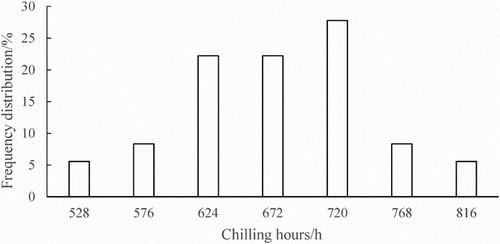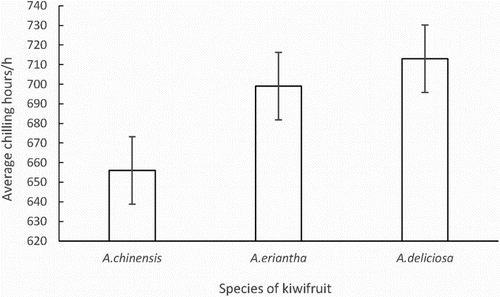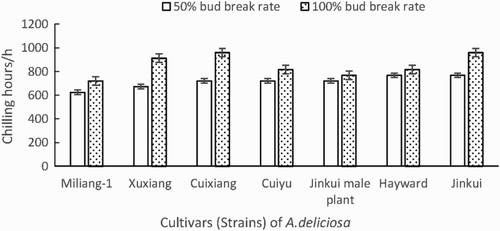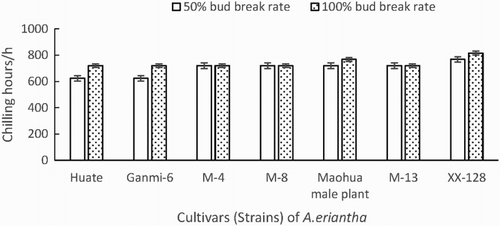ABSTRACT
The chilling requirements of 35 kiwifruit genotypes in south China were evaluated. The number of hours at low temperature (0–7.2°C) required to break natural dormancy was determined. Results showed that the average chilling requirement of the 35 genotypes was 675 h. The chilling requirement of 89% of the genotypes ranged from 576 to 768 h. Overall, the chilling requirements of genotypes of Actinidia chinensis var. deliciosa were higher than those of Actinidia eriantha, which in turn were higher than those of A. chinensis var. chinensis. These results provide a basis for breeding and selection of kiwifruit cultivars suitable for cultivation in low-chill areas of south China.
Introduction
Kiwifruit (Actinidia spp.) is a deciduous vine originating from China. Its fruit are a rich source of organic compounds such as amino acids, sugars, proteins, and a variety of minerals and vitamins necessary for the human body. The fruit has a very high vitamin C content, far exceeding that of pears, apples and oranges, and has been described as ‘the king of Vc’ and ‘the king of fruit’ (Xu & Zhang Citation2003). Consumption of kiwifruit is claimed to have several potential health benefits, such as catharsis and alleviation of intestinal diseases. Therefore, kiwifruit have become a popular fruit consumed by people of different ages (Huang et al. Citation2000; Ferguson & Huang Citation2007).
The growth of temperate deciduous fruit trees is arrested in winter to cope with adverse growing conditions. The chilling requirement refers to the number of hours of low temperature required to remove the natural dormancy of deciduous fruit trees. Cool temperatures affect the time of bud break and increase the amount of bud break and flowering of these crop which are referred to as having a ‘winter chilling’ requirement (Hall & McPherson Citation1997). It is a quantitative trait controlled by multiple genes (Wang & Hu Citation1992; Wang et al. Citation1996, Citation1997) and is an important characteristic that shows variation among species and genotypes. Insufficient winter chilling can result in abnormal growth and development including an extended flowering period, flower organ deformity and fruit abortion (Jiang et al. Citation2003). The minimum chilling requirements of deciduous fruit trees have to be satisfied after entering natural dormancy, otherwise the quality and yield of fruit will be seriously affected (Erez Citation1987, Citation1995). Previous study about controlled environment confirms that temperature has significant effects on the time of bud break (Hall & McPherson Citation1997). Ascertaining the chilling requirements is necessary for the planting and introduction of deciduous fruit trees suitable for different locations. The development of global climate warming has heightened interest in the chilling requirements of deciduous fruit trees selected for crop production (Gao et al. Citation2001; Wang, Wang, Gao, et al. Citation2009, Wang et al. Citation2011; Li, Qin, et al. Citation2011). Previous studies of the chilling requirements of deciduous fruit trees in China have focused on peach (Xiao et al. Citation2007; Li, Deng, et al. Citation2011; Chen et al. Citation2012), grape (Yang et al. Citation2001; Zhang & Wang Citation2004; Zhu et al. Citation2008; Wang, Wang, Wang, et al. Citation2009), pear (Li et al. Citation2011b, Citation2013; Feng et al. Citation2013) and blueberry (Yang et al. Citation2012; Liu Citation2013; Li et al. Citation2014). There have been few reports about the chilling requirements of kiwifruit (Chen et al. Citation2012). Snelgar et al. (Citation1997) proposed using hours below 7°C to break the endodormancy of Actinidia deliciosa. Because metabolism of cane is so slow below 0°C, Richardson units are defined as the accumulated hours between 0°C and 7°C (Grant et al. Citation1994; Samish & Levee Citation1962). In this study, we measured the number of hours at between 0°C and 7.2°C required to break dormancy in 35 different kiwifruit genotypes (Darbyshire et al. Citation2011; Zhuang et al. Citation2012). The results provide a basis for the introduction, rational distribution and promotion of cultivars suited to different locations, and lay the foundations for the breeding and selection of low-chill kiwifruit cultivars in south China.
Materials and methods
Plant materials
On 18 December 2015, after leaf-fall, 35 different kiwifruit cultivars and genotypes, including those of A. chinensis var. chinensis, A. chinensis var. deliciosa and A. eriantha, (), were collected from a kiwifruit germplasm nursery in Fengxin County, Jiangxi, China. About 30 annual dormant branches that had grown robustly with no plant disease symptoms or insect pests and with similar growth vigour were selected from individual plants of each genotype. About 30–40 cm of each branch was retained after trimming both ends.
Table 1. The classification of different cultivars and genotypes of kiwifruit used in this study.
Measurement of chilling requirement
The relative chilling requirements of all Actinidia genotypes were measured according to the method of Yang et al. (Citation2010).
Collection and processing of experimental material
At 8 pm on 18 December 2015, the branches were placed in a refrigerator at about 4°C for low-temperature treatment. Branches of all genotypes were removed from the refrigerator in batches every two days from 5 January to 27 January 2016, and cut into small fragments with 3–6 plump buds in each fragment. About 15–17 buds of each cultivar were used at each sampling date. The basal end of each fragment was cut diagonally and inserted into plastic containers filled with clean water. About 2–3 cm of each fragment was submerged. The fragments were placed in a greenhouse at 25°C, with a 16/8 h (day/night) photoperiod regime until bud break occurred. About every two days, the water was changed and 2–3 mm of wood was cut off from the base of each fragment to prolong efficient water uptake. The bud break rates of all genotypes were scored 20 days later.
Statistical estimation of rate of bud break
A bud was deemed to have broken dormancy when the bud scale on top of the bud showed green. The chilling requirement of a genotype was deemed to have been achieved when 50% or more of the buds had broken on two successive sampling dates. Data from the first of those sampling dates were used to estimate the low-temperature requirement and bud break rate.
Results
Comparison of the chilling requirements of 35 kiwifruit genotypes
The mean chilling requirement of the 35 kiwifruit genotypes tested was 675 h (range: 528–816 h), with a standard deviation of 72 h, and a coefficient of variation of 10.61% (). The frequency distribution () shows a skewed normal distribution after normality testing. The chilling requirements could be classified into three grades according to the frequency distribution (). Genotypes with a chilling requirement of ≤600, 601–744 or ≥745 h were classified as grades 1, 2 or 3, respectively.
Table 2. Statistical analysis of the chilling requirements of different cultivars and genotypes of kiwifruit.
Table 3. Scale index of the chilling requirements of reference cultivars of kiwifruit.
Comparison of the chilling requirements among various kiwifruit genotypes
The A. chinensis var. chinensis genotypes had the lowest chilling requirement (656 h), and those of A. chinensis var. deliciosa had the highest (713 h). The A. eriantha genotypes were intermediate (699 h), (). Among the 35 kiwifruit genotypes tested, the chilling requirements of Hort16A and Qihong were the lowest (528 h), while those of Jinfeng and male Fenghuang-1 male plant were the highest (816 h). Those of the other genotypes fell mainly in the range of 576–768 h, which accounted for 89% of the genotypes tested.
Comparison of the chilling requirements of various A. chinensis var. chinensis genotypes
Among the yellow-fleshed genotypes tested, the chilling requirements of Fenghuang-1 male plant and Jinfeng were the highest (816 h), and these cultivars were classified as grade 3. The chilling requirements of the other cultivars fell in the range of 624–720 h, and were classified as grade 2. These accounted for 67% of the A. chinensis var. chinensis cultivars tested. Also, Hort16A and Cuipihongxiang had the lowest chilling requirement to achieve 100% budbreak (672 h), while Fenghuang-1 male plant had the highest (960 h). Among the remaining genotypes, to achieve 100% bud break, Zaoxian, Yunhai-1, Fenghuang-1 and Wuning-2 needed 720 h of chilling; Jinyan, Jinyan male plant, YH-1, YH-2, Wuning-1, Lushanxiang and Kuimi, 768 h; Huayou, 816 h; Jinfeng, 864 h; and Fenghuang-2, 912 h ().
Figure 3. A comparison of the chilling requirements of different genotypes of yellow-fleshed kiwifruit.
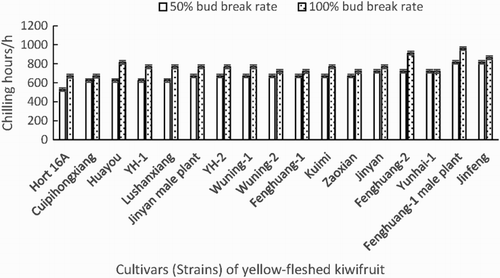
The chilling requirements of red-fleshed kiwifruit to break natural dormancy were relatively low. Qihong had the lowest chilling requirement (528 h). The chilling requirements of Qihong, Hongyang, Ganmi-7 and Chuhong were classified as grade 1 according to the grading scale. All four cultivars needed 768 h of chilling to achieve 100% bud break ().
Figure 4. A comparison of the chilling requirements of different genotypes of red-fleshed kiwifruit.
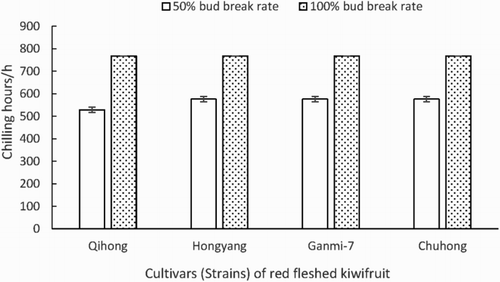
In summary, the yellow-fleshed cultivars were classified as grade 1, 2 or 3, while the four red cultivars tested were all classified as grade 1. Thus, in the A. chinensis var. chinensis genotypes tested, the yellow-fleshed cultivars tended to have a higher chilling requirement than the red-fleshed cultivars.
Comparison of the chilling requirements of various A. chinensis var. deliciosa cultivars
Among the seven A. chinensis var. deliciosa cultivars tested, the chilling required to break natural dormancy was lowest in Miliang-1 (624 h), followed by Xuxiang (672 h), Cuixiang, Cuiyu and Jinkui male plant (720 h), and Hayward and Jinkui (768 h) (). The chilling requirements of Miliang-1, Xuxiang, Cuixiang, Cuiyu and Jinkui male plant were classified as grade 2 based on the proposed grading scale, while those of Hayward and Jinkui were classified as grade 3. Miliang-1 needed the least amount of chilling hours to achieve 100% bud break (720 h), while Cuixiang and Jinkui needed the most (960 h), ().
Comparison of the chilling requirements of various A. eriantha genotypes
Among the seven A. eriantha cultivars tested, Huate and Ganmi-6 had the lowest chilling requirement (624 h), followed by M-4, M-8, M-13 and A. eriantha male plant (720 h), and XX-128 (768 h). The chilling requirements of Ganmi-6, Huate, M-4, M-8, M-13 and A. eriantha male plant were classified as grade 2, while that of XX-128 was classified as grade 3 on the proposed grading scale.
In the last statistics, all of the varieties (strains) had reached 100% bud break eventually.
Discussion
Lionakis and Schwabe (Citation1984) reported that results from use of rootless cutting were similar to those using intact canes (Snelgar et al. Citation1997), but Snowball and Smith (Citation1996) reported that cutting produce more flowers per dormant bud than field-grown plants. And more flowers tend to develop on cuttings originating from nodes 6 to 20, starting from the base of the original cane (Wall et al. Citation2008).
Song et al. (Citation2002) suggested in their research on grape, peach, nectarine and apricot that there were marked differences in the chilling requirements among various tree species and cultivars. The chilling requirement of grape was the highest, reaching from 1010 to 1840 h, while those of peach and nectarine were the lowest (620 to 910 h for flower buds, and 500 to 890 h for leaf buds), with apricot being intermediate (790 to 910 h). The chilling requirements of the Actinidia genotypes tested in this experiment ranged from 528 to 816 h, which is lower than those of grape and apricot and between those of the flower and leaf buds of peach and nectarine. There was also greater variation among the Actinidia genotypes than among the genotypes of the other tree crops tested.
The results showed that the chilling requirement of Jinkui (768 h) was lower than that of Jinfeng (816 h). This difference might be attributable to the environmental conditions prevalent in the locations from which these cultivars were selected (Hanninen Citation2011; Arora et al. Citation2003). Jinfeng was selected from the Hong Tou Mountain at an altitude of 1050 m in Fengxin County, Jiangxi Province, while Jinkui originated from a low altitude location in Hubei Province. The A. chinensis var. chinensis genotypes had the lowest mean chilling requirement, followed by the A. eriantha genotypes. The A. chinensis var. deliciosa genotypes had the highest mean chilling requirement. This result was consistent with previous studies suggesting that the chilling requirement of A. chinensis var. deliciosa is generally higher than that of A. chinensis var. chinensis (Yang et al. Citation2010).
As the global warming trend continuously advances, it is important to determine the chilling required by crops to break natural dormancy, especially for deciduous fruit trees. Warm winters led to a prolonged bud break, and few flowers are produced (Linsley-Noakes & Allan Citation1987). If the chilling requirement cannot be met, the economic benefits of fruit trees will be seriously affected. Today, the kiwifruit is widely favoured by consumers and producers because of its rich nutrient content and unique health benefits. The area of cultivated kiwifruit has expanded substantially in recently years, especially in China. For example, while the northern areas of Jiangxi Province are traditional production areas of kiwifruit, planting in southern areas has gradually increased. The results of this study can provide a reference for the selection of low-chill cultivars for warmer low altitude areas, and lay a foundation for the breeding and selection of cultivars suited to different climatic zones.
Conclusions
In this study, we found differences in chilling requirement among genotypes of kiwifruit. The chilling requirements were different from those of some other fruit tree species (). These results provide a basis for the introduction, rational distribution and the promotion of cultivars suited to different locations, and lay the foundation for the breeding and selection of low-chill cultivars.
Table 4. Analysis on the difference of chilling requirement of different kiwifruit varieties (strains).
Acknowledgement
We thank Alan Seal of the Plant and Food Research Institute of New Zealand for comments on an earlier draft.
Disclosure statement
No potential conflict of interest was reported by the authors.
Additional information
Funding
References
- Arora R, Rowland LJ, Tanino K. 2003. Induction and release of bud dormancy in woody perennials: a science comes of age. Horticultural Science. 38(5):911–921.
- Chen M, Ye W, Liu Z, Zhong H, Liu X, Pan Z. 2012. The requirements of chilling for bud dormancy and caloric for blooming for 12 peach varieties. Scientia Silvae Sinicae. 48(1):86–90.
- Darbyshire R, Webb L, Goodwin I, Barlow S. 2011. Winter chilling trends for deciduous fruit trees in Australia. Agricultural and Forest Meteorology. 151(8):1074–1085. doi: 10.1016/j.agrformet.2011.03.010
- Erez A. 1987. Chemical control of budbreak. Hortscience. 22(6):1240–1243.
- Erez A. 1995. Means to compensate for insufficient chilling to improve bloom and leafing. Acta Horticulturae. 395(395):81–96. doi: 10.17660/ActaHortic.1995.395.7
- Feng L, Ma C, Wu H, Qi K, Zhang S. 2013. Comparative studies of chilling requirement and covering time of forcing cultivation of different pear cultivars in Nanjing. Chinese Agricultural Science Bulletin. 29(4):94–98.
- Ferguson AR, Huang H. 2007. Genetic resources of kiwifruit: domestication and breeding. Horticultural Reviews. 33:1–121.
- Gao D, Shu H, Li X. 2001. Research on several chilling requirements suitable for cultivated fruit trees. Acta Horticulturae Sinica. 28(4):283–289.
- Grant JA, Polito VS, Ryugo K. 1994. Flower and fruit development: an overview. In: Kiwifruit growing and handling. University Division of Agriculture and Natural Resources Publication 3344, CA.
- Hall AJ, McPherson HG. 1997. Modelling the influence of temperature on the timing of bud break in kiwifruit. Acta Horticulturae. 444:401–406. doi: 10.17660/ActaHortic.1997.444.62
- Hanninen H. 2011. Effects of climatic change on trees from cool and temperate regions: an ecophysiological approach to modelling of bud burst phenology. Canadian Journal of Botany. 73(2):183–199. doi: 10.1139/b95-022
- Huang H, Gong J, Wang S, He Z, Zhang Z, Li J. 2000. Genetic diversity in the genus Actinidia. Biodiversity Science. 8(1):1–12.
- Jiang W, Han H, Wang L, Ma K. 2003. Advance in research of chilling requirement and the mechanism of deciduous fruit crops. Journal of Fruit Science. 20(5):364–368.
- Li W, Deng J, Zhang Q, Zhong B. 2011. Studies on chilling requirements of peach in Chengdu, Southwest China. Journal of Agricultural University. 24(3):1077–1081.
- Li X, Qin Z, Tu J, Yang F, Zhu H, Liu X. 2011. Study on chilling requirement of different pear cultivars. Journal of Henan Agricultural Sciences. 40(7):126–129.
- Li X, Qin Z, Tu J, Yang F, Zhu H, Wu T. 2013. Estimating models of chilling requirement for pear. Acta Agriculturae Boreali-occidentalis Sinica. 22(5):68–71.
- Li W, Deng J, Zhang Q, Zhong B. 2014. Chilling requirements of ‘Xinquan’ and four other pear cultivars. Journal of Southern Agriculture. 45(6):1035–1038.
- Linsley-Noakes GC, Allan P. 1987. Effects of winter temperatures on flower development in two clones of kiwifruit (Actinidia deliciosa, (A. Chev.) C.F. Liang et A.R. Ferguson). Scientia Horticulturae. 33(3):249–260. doi: 10.1016/0304-4238(87)90072-0
- Lionakis SM, Schwabe WW. 1984. Bud dormancy in the Kiwi Fruit, Actinidia chinensis Planch. Annals of Botany. 54(4):467-484. doi: 10.1093/oxfordjournals.aob.a086818
- Liu X. 2013. Study on molecular marker-assisted breeding with single nucleotide polymorphisms linked to cold hardiness and chilling requirement in blueberry. Beijing Forestry University.
- Samish RM, Levee S. 1962. The chilling requirements of fruit trees. National University Institute of Agriculture. 551:372–388.
- Snelgar WP, Manson PJ, McPherson HG. 1997. Evaluating winter chilling of kiwifruit using excised canes. Journal of Horticultural Science. 72(2):305–315. doi: 10.1080/14620316.1997.11515517
- Snowball AM, Smith RC. 1996. Flowering and fruiting rootless cuttings of kiwifruit. New Zealand Journal of Crop and Horticultural Science. 24(4):355–360. doi: 10.1080/01140671.1996.9513972
- Song Y, Shi Z, Gao D. 2002. Research on the chilling requirements for fruit trees in southwest region of Shandong. Deciduous Fruit. 34(6):1–3.
- Wall C, Dozier W, Ebel RC. 2008. Vegetative and floral chilling requirements of four new kiwi cultivars of Actinidia chinensis and A. deliciosa. Hortscience: A Publication of the American Society for Horticultural Science. 43(3):644–647.
- Wang H, Wang B, Wang X, Wei C, Liu W, Liu F. 2009. Study on chilling requirement of 22 important grape cultivars for protected cultivation. Sino-Overseas Grapevine & Wine. 11:20–22+25.
- Wang H, Wang X, Gao D, Wang B, Liu F. 2009. Growth, dormancy and freezing tolerane of different chilling requirement peach cultivars under seasonal changes. Acta Botanica Boreali-Occidentalia Sinica. 29(10):2058–2062.
- Wang H, Wang X, Wang B, Wei C, Liu W, He J, Liu F. 2011. Chilling and heat requirement and relationship between them for major grape cultivars under protected culture. Journal of Fruit Science. 28(1):37–41.
- Wang L, Hu N. 1992. Chilling requirements of peach varieties. Journal of Fruit Science. 9(1):39–42.
- Wang L, Zhu G, Zuo Q. 1996. Study on the genetic characteristics of chilling requirement of peach. Journal of Fruit Science. 13(4):237–240.
- Wang L, Zhu G, Zuo Q. 1997. Study on chilling requirement of peach varieties of China. Acta Horticulturae Sinica. 24(2):194–196.
- Xiao X, Zhang J, Zhang L, Yao X. 2007. A study on buds chilling requirements of several new peach cultivars. Journal of Inner Mongolia Agricultural University. 28(3):77–79.
- Xu X, Zhang Q. 2003. Researches and utilizations of germplasm resource of kiwifruit in China. Chinese Bulletin of Botany. 20(6):648–655.
- Yang T, Li S, Jiang A, Luo J, Jin P, Shan C. 2001. Study on the chilling requirement of grape cultivars and the methods for breaking the dormancy. Journal of Fruit Science. 18(6):321–324.
- Yang Y, Gao J, Qu X, Gu Q, Liu S, Xu X. 2010. Study on the chilling requirement of different cultivars of kiwifruit. South China Fruit. 39(1):75–76.
- Yang Y, Wei Y, Wu B. 2012. Research progress on physiological characteristics and chilling requirement of blueberry. Liaoning Agricultural Sciences. 3:42–46.
- Zhang Y, Wang H. 2004. Measurement and Practical Study on cold requirement of major culture varieties in the culture of greenhouse grape. Journal of Gansu Forestry Science and Technology. 29(1):25–27.
- Zhu Y, Qiao G, Wang Z, Guo S. 2008. Study on chilling requirement of fifteen grape cultivars. China Fruits. 6:16–18.
- Zhuang W, Zhang Z, Shi T, Wang P, Shao J, Luo X, Gao Z. 2012. Advance on chilling requirement and its chilling models in deciduous fruit crops. Journal of Fruit Science. 29(3):447–453.

